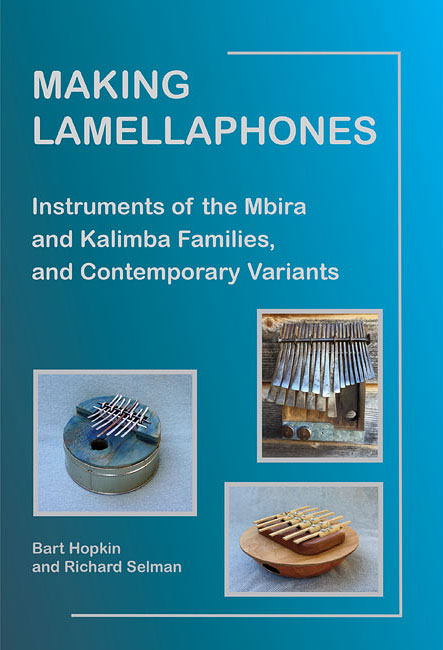Making Lamellaphones: Instruments of the Kalimba and Mbira Families, and Contemporary Variants
Book by Bart Hopkin and Richard Selman
233 pages, paperbound, 6″ x 9″, extensively illustrated with color photographs. Published by Experimental Musical Instruments, 2016. Audio examples illustrating the ideas in this book are available for free online: Go to www.soundcloud.com and search on “making lamellaphones.” (A few audio samples are also included at the bottom of this page.)
This book tells you how to make lamellaphones of all sorts. Lamellaphones are musical instruments like those pictured on this book’s cover, in the family of mbira, kalimba, and countless related forms: a tuned array of tines of metal or other material are mounted on a soundboard for plucking by the thumbs or fingers to produce harmonies and melodies. While the family has its roots in the music cultures of southern Africa, music lovers all over the world have enjoyed making and playing these instruments in forms both traditional and innovative.
In these pages you’ll find plans and ideas for a large and wonderfully diverse variety of lamellaphones ranging from simple to sophisticated. In addition, the book fully explores both the practical and acoustic aspects of the instruments, providing the understanding and know-how that will allow you to create instruments of your own design.
The book opens with a chapter containing an overview of the topic, with background information on lamellaphones and their history, supplemented by photos of many wonderful examples.
The second chapter presents plans for a simple model instrument. Whether or not you choose to actually make this instrument, this chapter introduces you in a practical way to all of the essential principles at play in lamellaphone design.
The following three chapters delve more deeply into lamellaphone-making essentials, with in-depth information on acoustics, construction, materials, and tuning.
Then comes a chapter devoted to the making of what is perhaps the most sophisticated and beloved of lamellaphone types, the mbira of the Shona people of Zimbabwe. This chapter is rich in cultural context, generously complemented with photos of traditional makers, their instruments, and their workspaces.
The last chapter — and it’s a very long, full, and wide-ranging one — is called “More Ideas and Plans.” It presents information on over thirty different lamellaphones, some with complete sets of plans and some as photos and descriptions that will allow you to explore the possibilities on your own. The instruments in this section make up quite a cast of characters: some of them are simple and straightforward, while plenty of others are far out and innovative.
Completing the book are appendixes on overtone tuning, electric pickups, and mathematical topics.
Audio samples for the instruments featured in this book can be found online and heard for free by going to soundcloud.com and searching for “making lamellaphones”.

